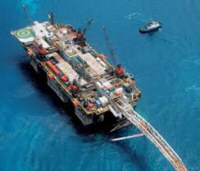|
South Stream Transport
awards contracts for line pipe supply of
the Second Offshore Pipeline
Saipem Contracted for the Construction of
the South Stream Offshore Pipeline
Marubeni-Itochu & Sumitomo
Consortium, OMK Steel and Izhora Pipe Mill
to supply pipes for the second
line of the South Stream Offshore Pipeline
Total contract value of
approximately 800 million euros
March 14, 2014 + + + South Stream
Transport has ordered over 75,000 pipes for second line of the South
Stream Offshore Pipeline, with a total order value of about 800
million euros. Marubeni-Itochu & Sumitomo Consortium from Japan will
supply 40% of the pipes, OMK Steel from Russia 35%, and Izhora Pipe
Mill from Russia another 25%.
 |
 |
Dr. Oleg
Aksyutin, CEO of South Stream Transport, and Vladimir Markin, CEO
of OMK
|
Dr. Oleg Aksyutin, CEO of South Stream
Transport, and Vitaly Motorin, General Manager of Severstal Izhora
pipe mill |
The South Stream Offshore Pipeline
will be made up of four parallel pipelines of 931 kilometres each. Each
pipeline is constructed of over 75,000 pipes of 12 metres each.
Pipe-supply contracts for the first line were signed in January 2014 with
producers in Germany (Europipe) and Russia. Following delivery and
stockpiling of pipes at the Black Sea coast, offshore construction
will start in autumn 2014. The first offshore pipeline is scheduled to
start operations by the end of 2015.
+ + +
Saipem Contracted for the Construction of the South Stream
Offshore Pipeline
Total contracts value of approximately 2 billion
Euros
Saipem to construct the first line, shore crossings and
associated facilities
for all four pipelines
March 14, 2014 + + +
South Stream Transport has contracted the Italian company Saipem for the
construction of the South Stream Offshore Pipeline. Oleg Aksyutin, CEO
of South Stream Transport B.V. and Stefano Bianchi, SVP of Saipem S.p.A
signed the contracts in Amsterdam today.
The South Stream
Offshore Pipeline will consist of four parallel gas pipelines each 931
kilometres long across the Black Sea, from Russia to Bulgaria. Each
pipeline will be made up of over 75,000 individual pipes which are welded
together on-board special pipe-laying vessels and then laid at depths
of up to 2,200 metres. The agreements with Saipem cover the design and
construction of line 1 and construction of the shallow water parts,, shore
crossings, landfall and associated facilities for all four pipelines.
Two vessels involved in pipeline construction
The South Stream
Offshore Pipeline will be laid by several pipe-laying vessels of Saipem:
Saipemís Castoro Sei, a S-lay vessel suitable for both shallow and
deep waters ... and Saipem 7000, a J-Lay vessel suitable for ultra-deep
water that had already constructed the Blue Stream pipeline in the
Black Sea.
 |
 |
| Saipem Castoro Sei (©
Saipem) |
Saipem S7000 (© Saipem) |
For the shore crossings, four micro-tunnels will be
constructed on both the Russian and the Bulgarian side, each with a
length of over 1 kilometre. These tunnels allow construction of the
pipeline without significant construction works at the surface of the
beach and shallow waters, thereby preserving the integrity of Russian and
Bulgarian shores and mitigating environmental impact.
Construction to start in June 2014
Activities at the landfalls will
commence in June of 2014 with the preparations for micro-tunnel
construction in both Russia and then in Bulgaria.
Offshore
construction will start in autumn 2014. In September 2014, the first pipes
will be welded together in batches of 4 on-board the Castoro Sei to
form so-called quad-joints of 48 metres long. In November 2014, the
Castoro Sei vessel will move to Russian waters to start offshore
pipe-laying. At the end of the year, the larger pipelay vessel S7000 will
take over pipe laying and the Castoro Sei will move back to the
Bulgarian harbour to continue quad-joint welding.
On board the
S7000, the 48-metre quad-joint pipes will be placed vertically in a large
tower (J-lay tower) and welded to the main string before being lowered
onto the seabed. This method is referred to as J-lay, referring to the
shape of the pipeline as it is lowered on the seabed.
Construction of the first pipeline is to last until the third quarter of
2015, so the completed Russia to Bulgaria pipeline will be taken into
operations phase by the end of that year.
Source: South Stream
Transport
media@south-stream-transport.com
www.south-stream-offshore.com
|

Worldwide more than
100,000 paid subscriptions
 Worldwide
more than 48,000 subscriptions - Worldwide
more than 48,000 subscriptions -
100% one-year direct request
qualification

'What's New' in Upstream, Midstream and
Downstream Products & Services
PennWell
Petroleum Group:
Oil & Gas Journal
Oil & Gas Journal Russia
OGJ LatinoAmericana
OGJ_eNewsletter
OGJ-Website-Statistics
Oil, Gas & Petrochem Equipment
Offshore Magazine
Offshore
Russia
Offshore eNewsletter
Offshore
Website Statistics
Oil & Gas Financial Journal
+ + +
For more information, media
kits or
sample copies please contact
Andreas
Sicking
+49 (0)2903-338570
wilhelms@pennwell.com
www.sicking.de
|






